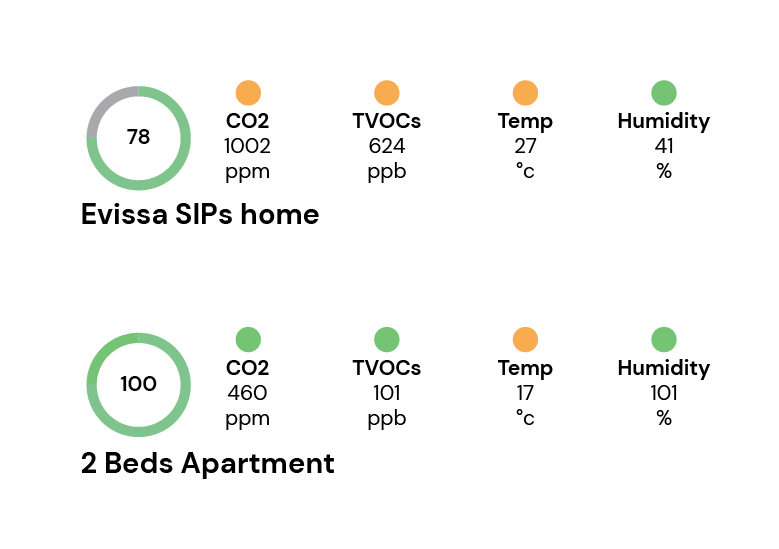Increase your IAQ with Passivhaus and Evissa’s SIPs Panels
Evissa’s SIPs and Passivhaus share a strong synergy due to their inherent features that promote the construction of building healthy dwellings with both reliable ventilation and good airtightness. In turn, this ensures good IAQ (indoor air quality) and helps minimise detrimental CO2 and TVOC levels in our living environments.
What is ventilation?
Ventilation is the intentional introduction of air into a building to maintain good air quality, this can be achieved both naturally and mechanically, for example opening a window allows for natural ventilation, while ventilation systems are mechanical ways of creating/moving air.
Good ventilation is crucial for IAQ, because it increases oxygen levels, that dilute carbon dioxide and airborne pollutants such as TVOCs, which can sometimes be higher than levels found outdoors.
What is airtightness?
A building that is airtight avoids the unintended introduction of outdoor air in or the loss of air out. As building construction methods and airtightness of homes improve, good ventilation becomes even more important for both our health and our energy efficiency.
Maintaining a healthy IAQ level isn’t just good for our power bills, it is essential for our health and well-being. Without detailing the building fabric attributes, IAQ is generally influenced by the size of the dwelling and its airtightness, with particular focus on the volume of air a dwelling holds - the larger the volume, the better the IAQ.
When it comes to apartment living, studies show the following, the general optimal air ratio for an apartment is 85m3 per occupant.
A 1-bedroom apartment holds between 90 - 120m3 of air for 1 - 2 occupants
A 2-bedroom apartment holds between 150 - 250m3 of air for 2 - 4 occupants
A 3 to 4-bedroom apartment holds between 270 - 400m3 of air for 3 - 5 occupants
Terrace houses are slightly bigger in volume, the general optimal air ration for a terrace home is 120m3 per occupant.
A 2-bedroom terrace holds between 380 - 420m3 of air for 3 - 4 occupants
A 3-bedroom terrace holds between 400 - 500m3 of air for 3 - 5 occupants
A 4-bedroom Standalone houses tend to enjoy the largest volumes of air more than 150m3 per occupant.
Looking at these indicators, it is clear - good venation is critical for smaller dwellings due to their lower air volumes, yet irrespective of the air ration per person, ventilation is essential for all spaces, large or small and developers, architects and even those renovating, should prioritise their ventilation systems to ensure healthy IAQ levels, especially in smaller spaces.
How does poor ventilation affect us?
In the study highlighted below, several sensors have been installed in different dwellings to monitor the quality of the indoor air in existing and new SIPs homes.
The study showed the following findings:
CO2 levels within the building increased 3-fold, while TVOCs levels within the building increased 10-fold, both due to lack of ventilation. Once appropriate ventilation was introduced, these levels were minimised as shown in the diagram below.

Why is it so important to minimise CO2 and TVOC levels?
At higher concentrations carbon dioxide can lead to increased respiratory rate, tachycardia, cardiac arrhythmias, drowsiness and impaired consciousness, while long term exposure to high levels of TVOCs (toxic volatile organic compounds) have found to cause kidney and liver damage, as well as respiratory and cardiovascular disease and even in some cases, cancer.
SIPs combined with Passivhaus’s principles clearly show that when the airtightness of a dwelling is elevated in conjunction with appropriate ventilation it can dramatically minimise the risk of harbouring harmful CO2 and TVOC levels in the home.
How do SIPs work?
Structural Insulated Panel systems (SIPs) are a healthy, energy efficient and robust alternative to traditional timber framed building construction. Evissa has designed our own proprietary SIPs to meet exacting Australian construction standards. Our SIPs are airtight, structurally sound, and accurate, with the ability to create thermally bridge-free enclosures on construction.
When combined with Passivhaus, in respect to the airtight and well-ventilated spaces, the highest levels of comfort and IAQ are achieved. As architects and certified Passivhaus designers, Evissa offers design and consultancy services for Passivhaus buildings,on all stages of project development, including planning, product selection and certification.
We believe the buildings we call home, have a profound effect on our long-term physical and mental well-being. In this way, we are committed to creating living spaces that not only look and feel beautiful but are also designed with your health in mind.
Featuring cutting edge technologies designed to minimise the risk of adverse health effects, while increasing the harmonious liveability of a space, be it a free-standing home, townhouse, or apartment building, our work proves you don’t have to sacrifice design to achieve a healthy and sustainable building.
At Evissa, we strive to to increase the awareness and adoption of creating healthy buildings and living spaces, designed in accordance with Passivhaus principles and SIPs construction.
We can advise you on all stages of your project - from planning to product selection to certification. Contact us to find out more.
Learn about: Counting Built Calories